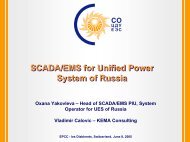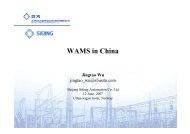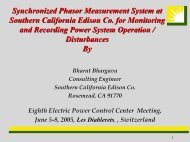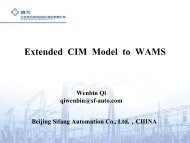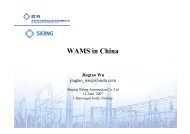Dynamic Line Rating in Real Time Markets
Dynamic Line Rating in Real Time Markets - Epcc-workshop.net
Dynamic Line Rating in Real Time Markets - Epcc-workshop.net
Create successful ePaper yourself
Turn your PDF publications into a flip-book with our unique Google optimized e-Paper software.
NYISO:<br />
<strong>Dynamic</strong> <strong>L<strong>in</strong>e</strong> <strong>Rat<strong>in</strong>g</strong> <strong>in</strong><br />
<strong>Real</strong> <strong>Time</strong> <strong>Markets</strong><br />
Muhammad Marwali<br />
Manager - Energy <strong>Markets</strong> Products, Market Structures<br />
New York Independent System Operator<br />
EPCC Workshop<br />
Bedford Spr<strong>in</strong>gs, PA<br />
June 4, 2013
NY Facts And Figures<br />
• 19.4 million people<br />
• 2012 load – 162,842 GWH<br />
• 320+ Market Participants<br />
• Over 300 generat<strong>in</strong>g units<br />
• Record peak -- 33,939 MW (Aug. 2, 2006)<br />
• 11,005 miles of high voltage transmission<br />
• 2013 Required Installed Capacity – 38,936 MW<br />
• $7.5 billion <strong>in</strong> market transactions annually<br />
2
NYISO<br />
Transmission<br />
Legend:<br />
765 kV<br />
500 kV<br />
345 kV<br />
230 kV<br />
DCCable<br />
230 kV and Above<br />
Erie South<br />
Beck<br />
2013<br />
Packard<br />
S. Ripley<br />
Niagara<br />
Dunkirk<br />
Somerset<br />
Huntley<br />
© 2013 New York Independent System Operator, Inc. All Rights Reserved.<br />
Sta. 80<br />
Pannell<br />
Rob<strong>in</strong>son Rd.<br />
Stolle Rd.<br />
Homer<br />
City<br />
Meyer<br />
Hillside<br />
Oswego<br />
Comple<br />
x<br />
Sithe<br />
Oswego<br />
Volney<br />
Elbridge<br />
Watercure<br />
N<strong>in</strong>e<br />
Mile<br />
E. Towanda<br />
Clay<br />
Lafayette<br />
Oakdale<br />
Saunders<br />
Adirondack<br />
Marcy<br />
Moses<br />
Central East<br />
Interface<br />
Fitzpatrick<br />
Scriba<br />
Edic<br />
Total East<br />
Interface<br />
H.T.P<br />
Porter<br />
Fraser<br />
Massena<br />
Chases<br />
Lake<br />
Gilboa<br />
Coopers<br />
Corners<br />
Rock<br />
Tavern<br />
Chateauguay<br />
Willis<br />
Patnod<br />
e<br />
Ryan<br />
Rotterdam<br />
Roseton<br />
Plattsburgh<br />
New<br />
Scotlan<br />
d<br />
Leeds<br />
Pleasan<br />
t Valley<br />
Alps<br />
Long<br />
Mounta<strong>in</strong><br />
E. Fishkill<br />
Bear Swamp<br />
Berkshire<br />
Frost Bridge<br />
New Haven<br />
Buchanan<br />
Norwalk<br />
Millwood<br />
Ramapo<br />
Cross Sound Cable<br />
Pleasantvill<br />
Ladentown<br />
e<br />
Spra<strong>in</strong>brook<br />
Branchburg<br />
Waldwick<br />
Dunwoodie<br />
W. Haverstraw<br />
Mott Haven<br />
Northport<br />
W49St/Ra<strong>in</strong>ey Hudson<br />
Shore Rd.<br />
Farragut<br />
L<strong>in</strong>den<br />
Shoreham<br />
L<strong>in</strong>den V.F.T<br />
Goethals<br />
New Bridge<br />
Sayreville, NJ<br />
E. Garden City<br />
Duley<br />
Athen<br />
s<br />
Neptune<br />
Cable<br />
Total East<br />
Interface<br />
LEEDS –PLEASANT VALLEY<br />
3
NYCA Load Profile by Zones<br />
August 2, 2006<br />
33,939 MWs<br />
2,735<br />
MW<br />
A<br />
50% of electric load<br />
located <strong>in</strong> New York City<br />
and Long Island<br />
B 2,110 MW<br />
C<br />
3,128<br />
MW<br />
E<br />
1,435<br />
MW<br />
J 11,300 MW<br />
F<br />
2,380 MW<br />
G<br />
2,436<br />
MW<br />
D 767 MW<br />
H 596 MW<br />
I 1,467 MW<br />
K 5,585 MW<br />
A. WEST<br />
B. GENESSE<br />
C. CENTRAL<br />
D. NORTH<br />
E. MHK VL<br />
F. CAPITL<br />
G. HUD VL<br />
H. MILLWD<br />
I. DUNWOD<br />
J. N.Y.C.<br />
K. LONGIL<br />
4
<strong>Real</strong>-<strong>Time</strong><br />
<strong>Markets</strong>
Energy Market <strong>Time</strong>l<strong>in</strong>e<br />
Who<br />
What<br />
Market Participants NYISO Market Participants NYISO<br />
Load Forecast, Load<br />
Energy Bids, Generator<br />
Offers for Energy, Reserve<br />
and Regulation and<br />
DADRP bids submitted for<br />
the day-ahead market<br />
Post<strong>in</strong>g of<br />
day-ahead<br />
schedules and<br />
LBMPs<br />
<strong>Real</strong>-time bid submission<br />
deadl<strong>in</strong>e<br />
Dispatch<br />
signals and<br />
calculation<br />
of RT LBMPs<br />
When<br />
Day Ahead<br />
5 A.M.<br />
11 A.M.<br />
75 M<strong>in</strong>.<br />
prior to<br />
Op. Hr.<br />
<strong>Real</strong> <strong>Time</strong><br />
Operat<strong>in</strong>g<br />
Hour<br />
How SCUC RTC & RTD<br />
6
<strong>Real</strong>-<strong>Time</strong> Market<br />
Input<br />
• RT Offers<br />
• Updates<br />
• DAM<br />
Commitments<br />
RTC<br />
RTD<br />
Output<br />
• Least Cost<br />
Solution<br />
• Meet reliability<br />
requirements<br />
Offers<br />
• RT Supply<br />
• Imports/Exports<br />
Updates<br />
• Transmission Model<br />
• Zonal Load Forecast<br />
• Changes <strong>in</strong> Operation<br />
<strong>Real</strong> <strong>Time</strong> Commitment<br />
<strong>Real</strong> <strong>Time</strong> Dispatch<br />
Software<br />
Post Results<br />
• Clear<strong>in</strong>g Prices<br />
• LBMP (GEN & Zonal)<br />
• Reserve, Regulation<br />
• Commitments, x15m<strong>in</strong>, 3hrs<br />
• Transactions<br />
• Generator---15m<strong>in</strong><br />
• Dispatch, x5m<strong>in</strong>, 1 hr<br />
• Energy---5 m<strong>in</strong><br />
• Reserve---5 m<strong>in</strong><br />
• Regulation---6 sec<br />
7
Security Constra<strong>in</strong>t Unit Commitment and<br />
Economic Dispatch Overview<br />
Generator/load data<br />
Load/reserve<br />
requirements<br />
Initial generator status<br />
Initial<br />
Unit<br />
Commitment<br />
Commitment<br />
Schedule<br />
Initial Unit Commitment (IUC)<br />
Solves for generation, reserve and load<br />
schedules that meet the generation and reserve<br />
requirements and the generator constra<strong>in</strong>ts.<br />
This module produces a base generator/load<br />
schedule which is used to obta<strong>in</strong> the <strong>in</strong>itial solved<br />
power flows for the network analysis programs.<br />
Revised Unit<br />
Commitment<br />
and Generation<br />
/Load Schedule<br />
Network<br />
Data<br />
Preparation<br />
Network<br />
Security<br />
Analysis<br />
Network<br />
Constra<strong>in</strong>ed<br />
Unit<br />
Commitment<br />
Network Flow<br />
Base Cases<br />
Network<br />
Constra<strong>in</strong>ts<br />
Network Data Preparation (NDP)<br />
Develops hourly, un-solved power flows based<br />
on the commitment and generation schedule<br />
from IUC and the network data<br />
Network Security Analysis (NSA)<br />
Solves hourly security analysis cases. If l<strong>in</strong>es<br />
(or <strong>in</strong>terfaces) limits are not satisfied for the <strong>in</strong>put<br />
schedule then NSA generates additional constra<strong>in</strong>ts<br />
for use by the NCUC function so that NCUC, <strong>in</strong> the<br />
next iteration, produces a schedule that is closer<br />
to satisfy<strong>in</strong>g the constra<strong>in</strong>ts.<br />
Network Constra<strong>in</strong>ed Unit Commitment (NCUC)<br />
Solves for generation, reserve and load schedules<br />
that meet the generation and reserve requirements,<br />
the generator constra<strong>in</strong>ts, the branch-flow<br />
constra<strong>in</strong>ts (produced by NSA)<br />
8
Network Security<br />
Analysis
NYISO Normal Operat<strong>in</strong>g State Criteria<br />
• Pre-Cont<strong>in</strong>gency (Actual) Flow Criteria:<br />
• Actual load<strong>in</strong>g of equipment def<strong>in</strong>ed as part of the NYS Transmission<br />
System should not exceed the associated Normal rat<strong>in</strong>gs of the<br />
equipment<br />
• Post-Cont<strong>in</strong>gency Flow Criteria:<br />
• Preventitive mode:<br />
• the loss of any s<strong>in</strong>gle generator, s<strong>in</strong>gle circuit, or adjacent circuits on the same<br />
structure, together with other facilities, which will trip at the same time due to pre-set<br />
automatic devices, will not cause any portion of the NYS Transmission System to<br />
exceed its LTE rat<strong>in</strong>g.<br />
• Corrective mode:<br />
• Underground cable : may exceed its LTE rat<strong>in</strong>g, but not its STE rat<strong>in</strong>g, provided 10-<br />
m<strong>in</strong>ute reserve or PAR control is available to return its post-cont<strong>in</strong>gency load<strong>in</strong>g to<br />
its LTE rat<strong>in</strong>g with<strong>in</strong> 15 m<strong>in</strong>utes, without caus<strong>in</strong>g another facility exceed its LTE<br />
rat<strong>in</strong>g<br />
• Overhead Transmission: with prior approval of the NYISO, the post-cont<strong>in</strong>gency<br />
load<strong>in</strong>g of any portion of the NYS Transmission System may exceed its LTE rat<strong>in</strong>g,<br />
provided sufficient control is available to return the load<strong>in</strong>g on the facility to its LTE<br />
rat<strong>in</strong>g with<strong>in</strong> 15 m<strong>in</strong>utes, without caus<strong>in</strong>g another facility to exceed its LTE rat<strong>in</strong>g<br />
10
NSA Mathematical Model<br />
All network constra<strong>in</strong>ts passed to NCUC are expressed <strong>in</strong> terms of generator shift<br />
factors and constra<strong>in</strong>t limits. The constra<strong>in</strong>t limits are dist<strong>in</strong>ct from the orig<strong>in</strong>al<br />
transmission constra<strong>in</strong>t rat<strong>in</strong>gs. They represent the aggregate effect of the shift<br />
factors and violations on the constra<strong>in</strong>ts.<br />
• If P<br />
pre , ij represents the precont<strong>in</strong>gency flow <strong>in</strong> branch, and this branch flow is the<br />
violated security constra<strong>in</strong>t then:<br />
max<br />
P<br />
(1)<br />
pre , ij<br />
Ppre<br />
, ij<br />
max<br />
• Where P pre,ij is the pre-cont<strong>in</strong>gency rat<strong>in</strong>g (Normal rat<strong>in</strong>g).<br />
The constra<strong>in</strong>t to be enforced is of the follow<strong>in</strong>g form<br />
<br />
max<br />
P<br />
ij<br />
Ppre, ij<br />
Ppre,<br />
ij<br />
(2)<br />
11
NSA Mathematical Model Cont<strong>in</strong>ued<br />
• Equation (2) is translated <strong>in</strong>to a l<strong>in</strong>ear function of the control variable C <strong>in</strong> terms of shift<br />
factors S,<br />
<br />
<br />
'<br />
max<br />
S<br />
kC<br />
k<br />
Sk<br />
( Ck<br />
Ck<br />
) Ppreij<br />
,<br />
Ppreij<br />
,<br />
• Equation (3) is further rearranged <strong>in</strong>to<br />
' max<br />
S kCk<br />
Ppre,<br />
ij<br />
Ppre,<br />
ij<br />
<br />
'<br />
• C k denotes the latest dispatch passed to NSA by NCUC/NCED and C k is the new<br />
dispatch to be solved by NCUC/NCED.<br />
S<br />
k<br />
C<br />
k<br />
(3)<br />
(4)<br />
12
Potential Research Areas: Post-<br />
Cont<strong>in</strong>gency Model<strong>in</strong>g Methodology<br />
• For both preventive mode and preventive/corrective mode:<br />
• Base network constra<strong>in</strong>ts are secured to the pre-cont<strong>in</strong>gency<br />
rat<strong>in</strong>gs<br />
• Post-cont<strong>in</strong>gency constra<strong>in</strong>ts are secured to either STE or<br />
LTE rat<strong>in</strong>gs (either 6-hour or post-cont<strong>in</strong>gency cont<strong>in</strong>uous as<br />
specified by the user) via the preventive actions or a mixture<br />
of the preventive/corrective actions<br />
• NSA mathematical model is appropriate when consider<strong>in</strong>g the<br />
pre-cont<strong>in</strong>gency constra<strong>in</strong>ts<br />
• Mathematical model will need to be modified for the postcont<strong>in</strong>gency<br />
constra<strong>in</strong>ts <strong>in</strong> which the post-cont<strong>in</strong>gency rat<strong>in</strong>gs are<br />
functions of the pre-cont<strong>in</strong>gency flows<br />
13
Model<strong>in</strong>g of Post-Cont<strong>in</strong>gency<br />
<strong>Rat<strong>in</strong>g</strong>s<br />
All post-cont<strong>in</strong>gency rat<strong>in</strong>gs are modeled as monotonically decreas<strong>in</strong>g<br />
piecewise-l<strong>in</strong>ear functions of the pre-cont<strong>in</strong>gency flows<br />
max<br />
P<br />
post,<br />
ij pre,<br />
ij<br />
P<br />
<br />
<br />
Pre-Cont<strong>in</strong>gency <strong>Rat<strong>in</strong>g</strong><br />
14
Post-Cont<strong>in</strong>gency Constra<strong>in</strong>t Limit<br />
Calculation Comparison<br />
' max<br />
S kCk<br />
Ppre,<br />
ij<br />
Ppre,<br />
ij<br />
<br />
S<br />
k<br />
C<br />
k<br />
(4)<br />
<br />
<br />
(<br />
post, k prek , k preij ,<br />
postij ,<br />
postk ,<br />
<br />
prek ,<br />
' 0<br />
0<br />
S S<br />
) C P<br />
<br />
P<br />
( S S ) C<br />
k<br />
(9)<br />
C k<br />
'<br />
C k<br />
• denotes the latest dispatch passed to NSA by NCUC/NCED, and is the<br />
new dispatch to be solved by NCUC/NCED.<br />
15
Benefits of the improved Post-<br />
Cont<strong>in</strong>gency Model<strong>in</strong>g methodology<br />
• The new methodology of post-cont<strong>in</strong>gency<br />
model<strong>in</strong>g offers several benefits<br />
• Cost effectiveness<br />
• Less constra<strong>in</strong>t means cheaper production cost<br />
• Congestion relief<br />
• Higher rat<strong>in</strong>g means less congestion<br />
• Does not compromise grid reliability<br />
• <strong>Rat<strong>in</strong>g</strong> is set based on the pre-cont<strong>in</strong>gency flow or amount of MW flow (NOTE: precont<strong>in</strong>gency<br />
flow impacts the temperature of the l<strong>in</strong>e, and temperature impacts the<br />
post cont<strong>in</strong>gency rat<strong>in</strong>g)<br />
• Optimized asset utilization<br />
• Lower prices to consumers<br />
• True <strong>L<strong>in</strong>e</strong> capacity <strong>in</strong> <strong>Real</strong>-<strong>Time</strong><br />
• Improved transmission efficiency<br />
16
The New York Independent System<br />
Operator (NYISO) is a not-for-profit<br />
corporation responsible for<br />
operat<strong>in</strong>g the state’s bulk electricity<br />
grid, adm<strong>in</strong>ister<strong>in</strong>g New York’s<br />
competitive wholesale electricity<br />
markets, conduct<strong>in</strong>g comprehensive<br />
long-term plann<strong>in</strong>g for the state’s<br />
electric power system, and<br />
advanc<strong>in</strong>g the technological<br />
<strong>in</strong>frastructure of the electric system<br />
serv<strong>in</strong>g the Empire State.<br />
www.nyiso.com<br />
17



